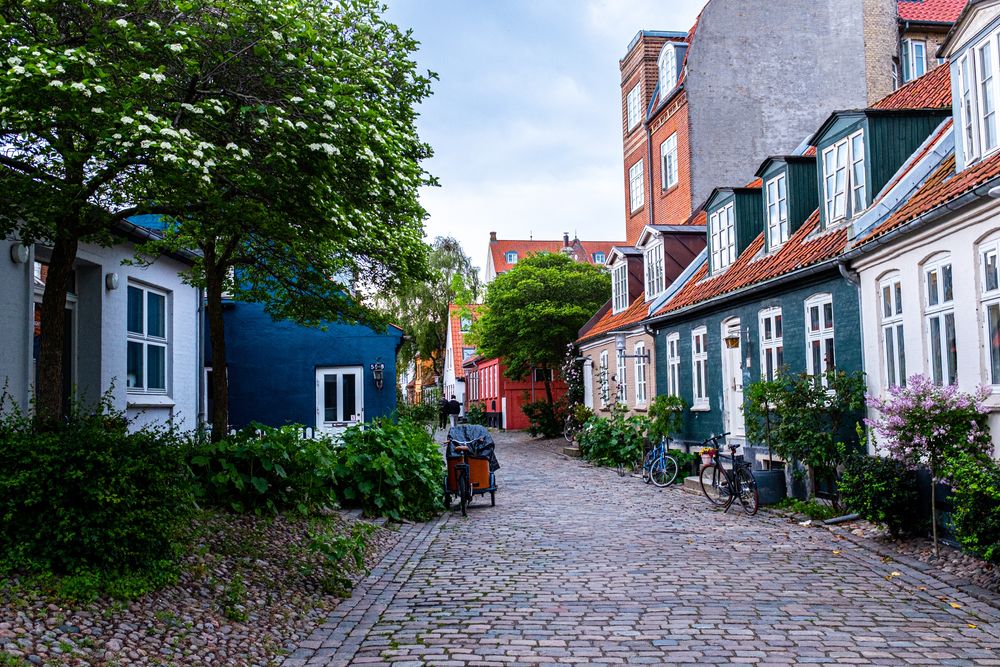Denmark Traffic Guide
Discover Denmark by Car
Denmark impresses families, couples, and singles with its unique location. Here, you can experience both the wild North Sea and the gentle Baltic Sea. The country offers idyllic old towns, picturesque beaches, and countless islands that are waiting to be explored. Although Denmark has a well-developed railway network connecting the major cities, traveling by car is still the best way to move around regionally. This allows you to flexibly admire the full diversity of Denmark.
In this guide, you will learn what to consider when driving in Denmark. What traffic rules should you know? What are the road conditions like? And do you need a rental car, or is traveling with your own car possible?
Denmark Traffic Rules Overview
- Driving is permitted in Denmark from the age of 18. The EU driving license is valid in Denmark without any additional supplement. An international driving license is not required for drivers from the EU.
- In Denmark, driving is on the right side, and the right-before-left rule applies.
- Within built-up areas, the speed limit in Denmark is a maximum of 50 km/h. Outside built-up areas on country roads and expressways, a speed of 80 km/h is permitted. On motorways, the respective posted maximum speed limit applies, which is usually 110 km/h, but can go up to a maximum of 130 km/h.
- During the drive, all vehicle occupants are required to wear seat belts. The driver may only use their mobile phone with a hands-free system. Additionally, the use of dipped headlights is mandatory throughout the year.
- Radar detectors are not permitted in Denmark.
- A warning triangle and a first aid kit must be carried in the vehicle at all times. It is also strongly recommended to carry a reflective vest and a fire extinguisher.
- For drivers, a maximum blood alcohol content of 0.5 per mille is allowed. If the limit of 2.0 per mille is exceeded, in addition to a driving ban, confiscation of the vehicle may also be imposed.
- When parking in Denmark, a parking disc should generally be used.
- White triangles (known as "shark teeth") on the road indicate at road junctions that you must yield.
- At pedestrian crossings, pedestrians must wait. Avoid sudden braking for pedestrians to prevent rear-end collisions.
- On Danish motorways, there are some important specifics to note when entering and exiting: the zipper method generally applies on entry. When exiting, note that deceleration lanes are not common in Denmark, so reduce your speed in good time.
Driving in Denmark
The roads in Denmark
Denmark boasts well-developed roads and a solid motorway network. The country includes not only the Jutland Peninsula and the largest island, Zealand, but also well over 1,000 smaller islands and countless bays.

The inhabited islands of the country are predominantly connected to the mainland by bridges and ferries. The bays, rivers, and straits that traverse Denmark are also well-crossed by bridges and causeways.
Danish road users are predominantly known for their calm and leisurely driving style. This is partly due to the low speed limits and the high fines for speeding. Those in a hurry will not find satisfaction on Danish roads.
In urban traffic, especially in the capital Copenhagen, special consideration should be given to cyclists. Denmark is very bicycle-friendly. Accordingly, it can be advisable to move around within city areas not by car but by bicycle, whether your own or a rental.
Petrol stations and charging points
Petrol and Diesel: The prices at Danish petrol stations are somewhat higher than in most other European countries. The network is extensively developed. Wherever you can drive, you can usually refuel. Many petrol stations for petrol and diesel now offer 24-hour self-service. Manned stations are typically open until 6 PM, and on busy roads and motorways, they can be found open until 10 PM.

Electric Cars: Denmark can be well-traveled with an electric car with the right planning and preparation. The coverage of charging stations is already acceptable and is continuously being expanded.
Especially in the east of the country, there are numerous charging options for electric cars. In the northwest and on the islands, it is still comparatively difficult to charge electric cars.
Hydrogen Cars: Denmark has a relatively dense network of hydrogen fuel stations. Most hydrogen stations are located in the south and east, around Copenhagen. The hydrogen network in the north is still under development.
Rental car or own car?
Denmark has only one, quite short, mainland border with Germany, spanning 67 kilometers. Therefore, the best way to reach Denmark by car is from Germany through Schleswig-Holstein. Alternatively, numerous ferry connections from various locations on the European mainland to Denmark are available.
Entering with a car bearing an EU license plate is generally straightforward. Although it is not mandatory to carry the International Insurance Card, it is highly recommended, as it may be required for handling insurance matters in the event of an accident.
For those who prefer not to drive their own car to Denmark, rental cars are available, especially in the cities, with many providers to choose from. The minimum age to rent a car in Denmark is 21 years, and additional fees may apply for drivers under 25 years of age.
Fines
Fines in Denmark are comparatively high, especially for speeding and driving under the influence of alcohol, which are subject to severe penalties. If caught driving under the influence of alcohol with a blood alcohol content of 2.0 per mille or higher, one must even expect that their car may be confiscated and auctioned off for the benefit of the Danish state treasury.

Excerpt from the fine catalog:
- Speeding (20 km/h over the limit): from 135 Euros (approx. £115)
- Speeding (over 50 km/h over the limit): from 500 Euros (approx. £430)
- Seatbelt violation: 200 Euros (approx. £170)
- Driving under the influence of alcohol: Blood alcohol content x monthly earnings (up to one month's earnings)
- Red light violation: 270 Euros (approx. £230)
- Using a mobile phone while driving: 200 Euros (approx. £170)
- Disregarding overtaking restrictions: 270 Euros (approx. £230)
- Illegal parking: from 70 Euros (approx. £60)
Conclusion: Comfortably and Safely Through Denmark
Exploring Denmark by car is definitely worthwhile if you want to see the entire country with all its facets. The roads are well-maintained, and Denmark is easily accessible by car. However, in the cities, you might find that getting around by bicycle is more efficient.
► Here you can find more information about the toll regulations in Denmark, to be optimally prepared for your vacation.






